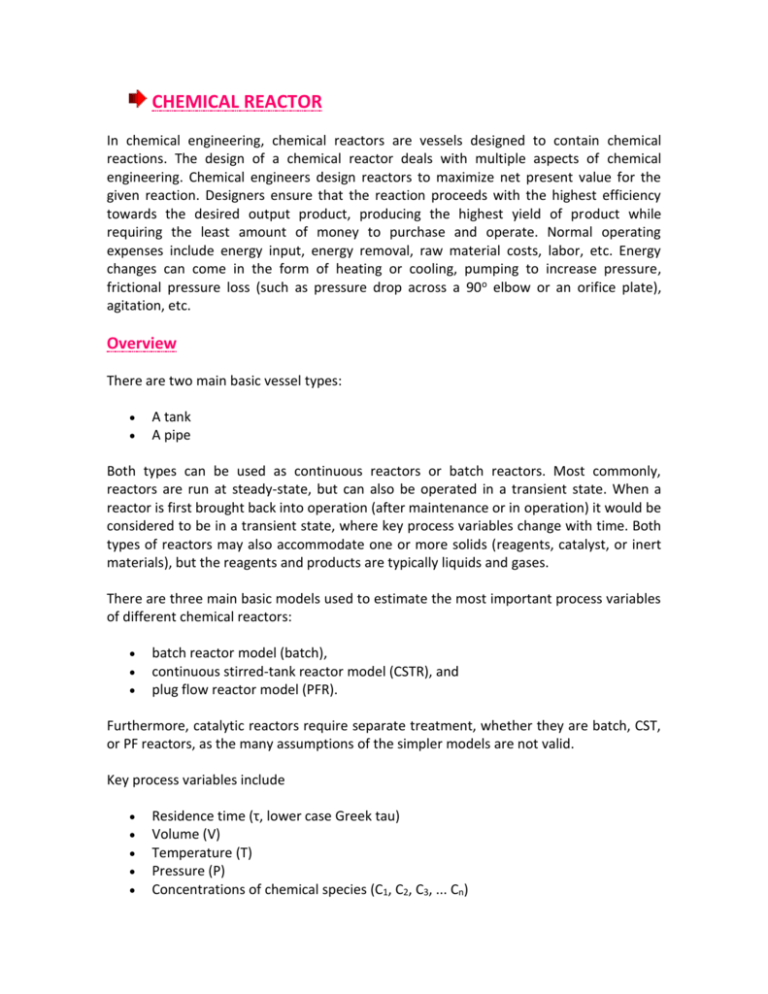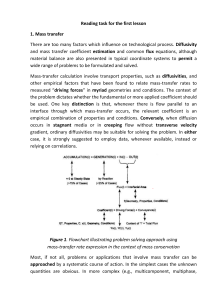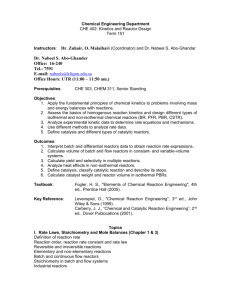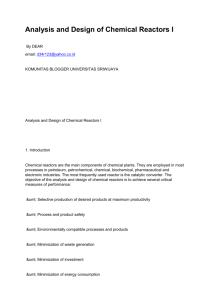Catalytic reactor
advertisement

CHEMICAL REACTOR In chemical engineering, chemical reactors are vessels designed to contain chemical reactions. The design of a chemical reactor deals with multiple aspects of chemical engineering. Chemical engineers design reactors to maximize net present value for the given reaction. Designers ensure that the reaction proceeds with the highest efficiency towards the desired output product, producing the highest yield of product while requiring the least amount of money to purchase and operate. Normal operating expenses include energy input, energy removal, raw material costs, labor, etc. Energy changes can come in the form of heating or cooling, pumping to increase pressure, frictional pressure loss (such as pressure drop across a 90o elbow or an orifice plate), agitation, etc. Overview There are two main basic vessel types: A tank A pipe Both types can be used as continuous reactors or batch reactors. Most commonly, reactors are run at steady-state, but can also be operated in a transient state. When a reactor is first brought back into operation (after maintenance or in operation) it would be considered to be in a transient state, where key process variables change with time. Both types of reactors may also accommodate one or more solids (reagents, catalyst, or inert materials), but the reagents and products are typically liquids and gases. There are three main basic models used to estimate the most important process variables of different chemical reactors: batch reactor model (batch), continuous stirred-tank reactor model (CSTR), and plug flow reactor model (PFR). Furthermore, catalytic reactors require separate treatment, whether they are batch, CST, or PF reactors, as the many assumptions of the simpler models are not valid. Key process variables include Residence time (τ, lower case Greek tau) Volume (V) Temperature (T) Pressure (P) Concentrations of chemical species (C1, C2, C3, ... Cn) Heat transfer coefficients (h, U) CSTR (Continuous Stirred-Tank Reactor) Reactor CSTR. Check of a condition of the case. In a CSTR, one or more fluid reagents are introduced into a tank reactor equipped with an impeller while the reactor effluent is removed. The impeller stirs the reagents to ensure proper mixing. Simply dividing the volume of the tank by the average volumetric flow rate through the tank gives the residence time, or the average amount of time a discrete quantity of reagent spends inside the tank. Using chemical kinetics, the reaction's expected percent completion can be calculated. Some important aspects of the CSTR: At steady-state, the flow rate in must equal the mass flow rate out, otherwise the tank will overflow or go empty (transient state). While the reactor is in a transient state the model equation must be derived from the differential mass and energy balances. The reaction proceeds at the reaction rate associated with the final (output) concentration. Often, it is economically beneficial to operate several CSTRs in series. This allows, for example, the first CSTR to operate at a higher reagent concentration and therefore a higher reaction rate. In these cases, the sizes of the reactors may be varied in order to minimize the total capital investment required to implement the process. It can be seen that an infinite number of infinitely small CSTRs operating in series would be equivalent to a PFR. The behavior of a CSTR is often approximated or modeled by that of a Continuous Ideally Stirred-Tank Reactor (CISTR). All calculations performed with CISTRs assume perfect mixing. If the residence time is 5-10 times the mixing time, this approximation is valid for engineering purposes. The CISTR model is often used to simplify engineering calculations and can be used to describe research reactors. In practice it can only be approached, in particular in industrial size reactors. PFR (Plug Flow Reactor) In a PFR, one or more fluid reagents are pumped through a pipe or tube. The chemical reaction proceeds as the reagents travel through the PFR. In this type of reactor, the changing reaction rate creates a gradient with respect to distance traversed; at the inlet to the PFR the rate is very high, but as the concentrations of the reagents decrease and the concentration of the product(s) increases the reaction rate slows. Some important aspects of the PFR: All calculations performed with PFRs assume no upstream or downstream mixing, as implied by the term "plug flow". Reagents may be introduced into the PFR at locations in the reactor other than the inlet. In this way, a higher efficiency may be obtained, or the size and cost of the PFR may be reduced. A PFR typically has a higher efficiency than a CSTR of the same volume. That is, given the same space-time, a reaction will proceed to a higher percentage completion in a PFR than in a CSTR. For most chemical reactions, it is impossible for the reaction to proceed to 100% completion. The rate of reaction decreases as the percent completion increases until the point where the system reaches dynamic equilibrium (no net reaction, or change in chemical species occurs). The equilibrium point for most systems is less than 100% complete. For this reason a separation process, such as distillation, often follows a chemical reactor in order to separate any remaining reagents or byproducts from the desired product. These reagents may sometimes be reused at the beginning of the process, such as in the Haber process. Continuous oscillatory baffled reactor (COBR) is a tubular plug flow reactor. The mixing in COBR is achieved by the combination of fluid oscillation and orifice baffles, allowing plug flow to be achieved under laminar flow conditions with the net flow Reynolds number just about 100. Semi-batch reactor A semi-batch reactor is operated with both continuous and batch inputs and outputs. A fermenter, for example, is loaded with a batch, which constantly produces carbon dioxide, which has to be removed continuously. Analogously, driving a reaction of gas with a liquid is usually difficult, since the gas bubbles off. Therefore, a continuous feed of gas is injected into the batch of a liquid. An example of such a reaction is chlorination. Catalytic reactor Although catalytic reactors are often implemented as plug flow reactors, their analysis requires more complicated treatment. The rate of a catalytic reaction is proportional to the amount of catalyst the reagents contact. With a solid phase catalyst and fluid phase reagents, this is proportional to the exposed area, efficiency of diffusion of reagents in and products out, and turbulent mixing or lack thereof. Perfect mixing cannot be assumed. Furthermore, a catalytic reaction pathway is often multi-step with intermediates that are chemically bound to the catalyst; and as the chemical binding to the catalyst is also a chemical reaction, it may affect the kinetics. The behavior of the catalyst is also a consideration. Particularly in high-temperature petrochemical processes, catalysts are deactivated by sintering, coking, and similar processes. A common example of a catalytic reactor is the catalytic converter following an engine.








